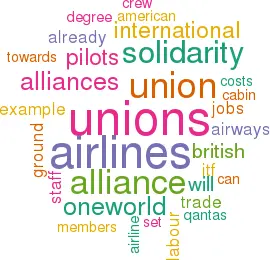oneworld, one-union?
October 1998


The launch of oneworld has significant implications for organised labour. Here, Aviation Strategy looks at how unions representing employees at British Airways, American, Cathay, Qantas and Canadian are reacting to the alliance through the creation of the “Oneworld Solidarity Alliance”, and examines the prospects for union solidarity across airlines.
A trade union alliance — the ABC Alliance — had already been set up in July of this year in anticipation of the oneworld alliance, representing cabin crew and ground staff working for British Airways, American Airlines and the other airlines expected to become members of oneworld. This union alliance, now renamed the “Oneworld Solidarity Alliance”, will join similar union pacts set up to co–ordinate organised labour’s responses to airlines' alliances.
The table on the right shows the extent to which pilots’ unions and those of cabin crew and ground staff have already responded to the alliances by creating their own groupings. The potential for international solidarity is greater among cabin crew and ground staff, since the majority of these workers are affiliates of the International Transport Workers Federation (ITF), the powerful, London–based international union federation. Some pilots’ unions, such as the American Airline Pilots Association (AAPA), are affiliated to the ITF, while others, such as the non–affiliated British Airline Pilots Association, only have informal links at present.
The tentative trend towards global unions groupings might prompt airline managements to wonder if — in creating their own alliances — they have propelled trade unions towards greater international co–operation and solidarity? This could rebound on airlines in the form of stiffened resistance to changes in working practices, outsourcing and other attempts to control labour costs. Pilots’ strikes at Northwest and Air Canada, for example, indicate a degree of militancy already exists, although these actions are not directly linked to alliances. On the contrary, other pilots unions within alliances helped undermine these strikes as Northwest shifted as many Atlantic passengers as possible over to KLM and Air Canada re–routed its traffic to United services at Chicago.
International solidarity?
The ITF’s ambition to emulate in aviation its success in the shipping industry, where it sets international labour rates and collects union dues, may therefore yet be frustrated.
Keeping a united front against alliance airlines which may seek to transfer jobs to lower–paid nationals will be the real test of the unions’ solidarity. Airlines will no doubt hope that pragmatism — more jobs for members, keeping existing jobs or retaining existing conditions for individual unions — will prevail over idealism, and so undermine any international solidarity. But unions argue that alliances have to take their workforces with them if they want to create a seamless, globally- branded entity, and so divide–and–rule tactics would be counter–productive.
Unions accept that there has been as yet no significant attack on jobs or conditions from the alliance airlines, but insist that the threat hangs over their members. The ITF, for example, says that Qantas benchmarked ground staff costs after its tie–up with British Airways and threatened to use outside contractors. Union unease has already resulted in some concessions. The ITF also points out that British Airways has transferred some of its ticketing and administration to Bombay, a route that Qantas is expected to follow.
Any talk, however, of alliance–based “supranational” collective bargaining is quickly dismissed by the unions themselves (although a trend towards centralisation of union activities is seen as inevitable). With whom, for example, would a centralised alliance–based union grouping negotiate if not the individual airlines? Only the Star alliance appears so far to have any centralised employment policy with its vacuous sounding “People’s Policy”.
In addition, alliances can add and drop member airlines and are linked to non–alliance airlines through bilaterals, making the task of the unions more difficult.
The best unions can hope to achieve is an exchange of information between themselves, just as airlines now more readily swap “benchmarking” data, so that they are better armed when going into negotiations. In different countries the degree of access to information can vary greatly, with Scandinavians and Germans, for example, benefiting from national legislation which puts employee representatives, including union officials, on companies’ supervisory boards. This could enable them to challenge the benchmarking figures where they suspect airlines have manipulated them to their own advantage.
The realistic prospect for the trade unions is that they maintain an acceptable degree of solidarity and achieve a consensus on a draft set of basic demands such as the rights to belong to a trade union, collective organisation etc. These are the kind of demands airlines should be able to accept without committing themselves to anything that either increases labour costs or leaves themselves open to industrial action. If oneworld works, there will still be many unions — albeit more co–ordinated and better informed — to deal with.